Recap: (In)visible - The Lived Realities of Contract Faculty
Yesterday, I attended and was a panelist at the Association of Part-Time Professors of the University of Ottawa’s inaugural conference - (In)visible: The Lived Realities of Contract Faculty. I had had the pleasure of assisting with the organization of the conference in the spring and working with other part-time faculty who were passionate not only about the conference but also about their careers, their students, and their research. Many “part-time” or sessional faculty actually work full-time as professors by taking on multiple contracts from several institutions, they also do departmental or university-wide service and research for which they are usually compensated as it falls outside of their regular course hours.
The conference, which took place over two days, sought to highlight, challenge, and examine the dynamics of academic invisibility locally, nationally, and internationally. Their were presentations on rendering contract faculty visible through film; (In)visibility and identity: marginalization, stress and stories of perseverance; and excavating the neoliberal university, as well as roundtable discussions on the following topics: Who is the ‘part-time’ professor; The Québec model; Adjunct researchers and administrators: shouldering the (mostly) unpaid burdens; and PhD students confront a challenging future. I was a panelist on the latter. The presentations and roundtable discussions were run in parallel sessions - I attended one of each before sitting on a panel myself.
The first roundtable discussion that I attended - “Who is the Part-Time Professor?” - aimed to debunk some of the myths surrounding the people and appointments of part-time faculty. The speakers highlighted the quantitative and qualitative characteristics of sessional faculty along with some of the challenges of actually collecting and measuring data.
Recent studies have shown that the number of contract faculty has increased at post-secondary institutions (in 2016-2017, more than half of all faculty appointments in Canada were contract positions) and we heard that 29% of contract faculty live close to or just above the poverty line. They’re also frustrated with the working conditions and feel that there exists a tiered system that fails to recognize their contributions to the post-secondary institutions that they work for and to academia more broadly. Some of these frustrations stem from the terminology that it is used to describe contract faculty - for example, the use of ‘contract’ or ‘part-time’ not only fails to recognize that many ‘contract’ faculty actually work full-time across multiple institutions - but also spoke about budget cuts, bigger class size, an increased workload that did not reflect compensation, and the uncertainty of (and wasted time spent) re-applying for classes year after year.
The second session that I attended - “Excavating the Neoliberal University” - considered the economic and structural conditions that have led to the emergence of a classist system of faculty in post-secondary institutions. What really struck me here were the estimates of how much (or rather how little) of universities’ budgets are apportioned to the salaries of part-time professors despite statistics that suggest that (at least at the University of Ottawa) approximately 65% of undergraduate classes are taught by part-time faculty. In addition, these presentations highlighted the amount and scope of ‘unpaid’ paid that contract faculty take on - service on committees, writing student references, preparing for and building new courses, taking part in student events, managing TAs, answering student emails, etc. This trend, however, is not just common at the university level - it’s a larger issue in the education sector generally, where teachers, instructors, are being asked to more with less.
After lunch, I participated on an interdisciplinary panel with other PhD students at various stages of their degrees and recent doctoral and post-doctoral graduates - “PhD Students Confront a Challenging Future” - to discuss how doctoral students can prepare themselves for a dismal job market (according to recent statistics, about one in six PhD students will end up with a tenure-track position) and what strategies they can use to improve their career prospects. We spoke about what inspired and motivated us to do a PhD - intellectual curiosity, public service, and a passion for research topped the list - and whether we doubted our decision to pursue a PhD - doubt is normal, and healthy, because taking on such a long-term, individually-driven endeavour can be scary and uncertain. Finally, we spoke about some of the strategies that we’re using to not only complete our doctorates but to thrive in the workforce afterwards; I emphasized taking an entrepreneurial approach to my studies, to pursuing only projects and opportunities that you’re truly interested in, and about being strategic in how you frame those activities and the skills that you honed while doing them. Yes, I realize that’s a very communications thing to say.
Finally, the conference closed with a breakout activity to unpack the contract faculty experience as it currently stands and to identify alternative structures and solutions to improve their working conditions.
Throughout the day, we had some tough conversations about the future of academia and the state of contract, sessional employment. The future may seem challenging, but, as I said in a different context last weekend, based on what I heard at the conference, I think it’s bright.

